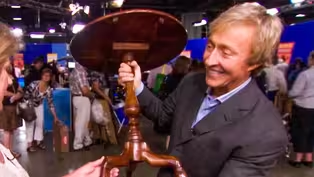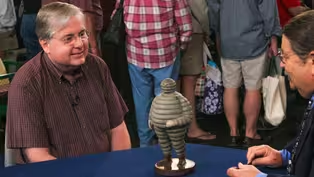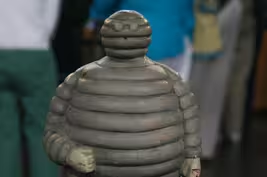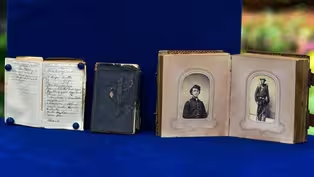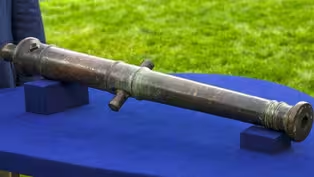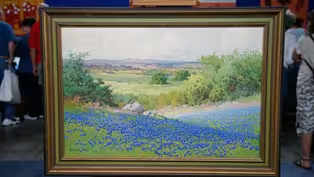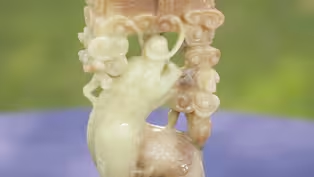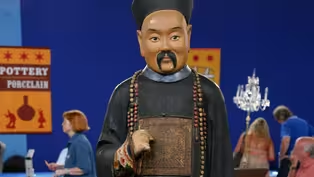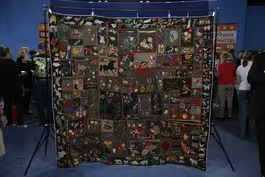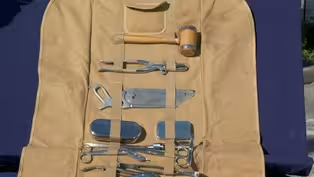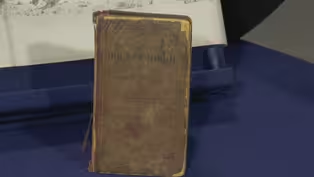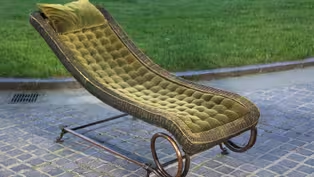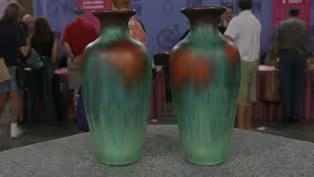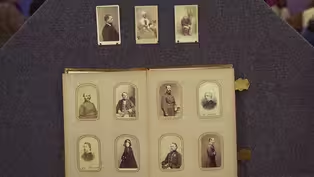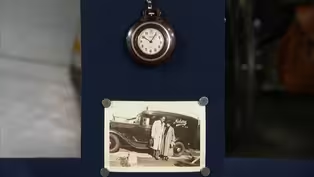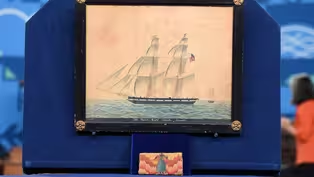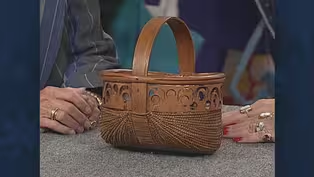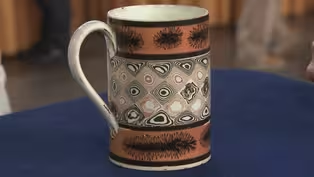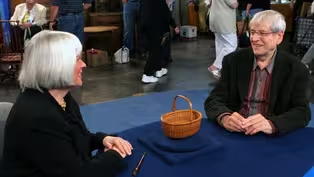
Never Seen That Before!
Season 29 Episode 22 | 52m 31sVideo has Closed Captions
Discover finds that even our experts hadn’t seen prior to these magical ROADSHOW moments!
Discover amazing items even our ROADSHOW experts had never seen, in person or possibly ever, prior to that magical moment at ROADSHOW. Finds include a Michelin Bibendum ad figure, a WWI surgical kit and a 19th c. southern basket.
Problems playing video? | Closed Captioning Feedback
Problems playing video? | Closed Captioning Feedback
Funding for ANTIQUES ROADSHOW is provided by Ancestry and American Cruise Lines. Additional funding is provided by public television viewers.

Never Seen That Before!
Season 29 Episode 22 | 52m 31sVideo has Closed Captions
Discover amazing items even our ROADSHOW experts had never seen, in person or possibly ever, prior to that magical moment at ROADSHOW. Finds include a Michelin Bibendum ad figure, a WWI surgical kit and a 19th c. southern basket.
Problems playing video? | Closed Captioning Feedback
How to Watch Antiques Roadshow
Antiques Roadshow is available to stream on pbs.org and the free PBS App, available on iPhone, Apple TV, Android TV, Android smartphones, Amazon Fire TV, Amazon Fire Tablet, Roku, Samsung Smart TV, and Vizio.
Buy Now
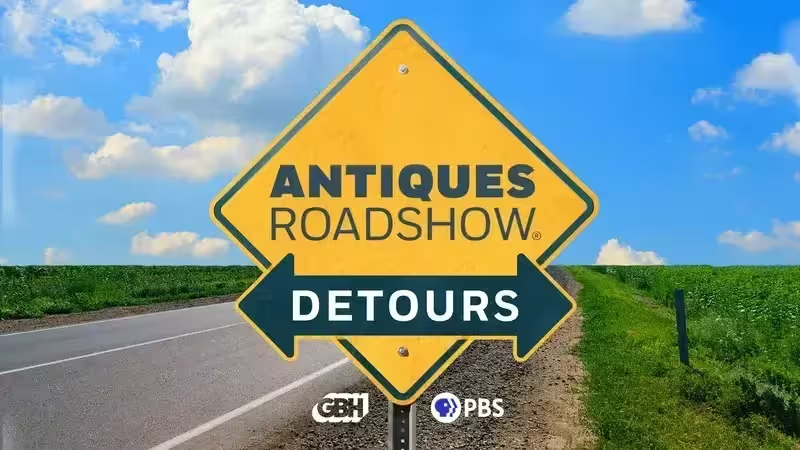
ANTIQUES ROADSHOW DETOURS
Ever wondered what happens to the treasures featured on America’s beloved ANTIQUES ROADSHOW after the cameras leave town? Host Adam Monahan tracks down the juicy afterlives of your favorite finds from PBS’s hit series.Providing Support for PBS.org
Learn Moreabout PBS online sponsorship♪ ♪ CORAL PEÑA: Our experts can hardly believe their eyes.
APPRAISER: We kind of gasped when we saw this.
I have never seen one before.
It's this really unusual form.
PEÑA: It's "Antiques Roadshow: Never Seen That Before!"
♪ ♪ PEÑA: Over a million treasured objects have come into "Roadshow" over the years.
But of that incredible number of artworks, collectibles, and antiques, there are some things that our experts haven't previously encountered.
In this special episode, we're highlighting items our appraisers had never seen before, until they saw it at "Antiques Roadshow."
GUEST: I brought you what I think is a very early Michelin Man.
My wife gave me this about 20 years ago as a birthday present.
She knows I like old advertising pieces, and, uh, managed to find this at a yard sale.
Was sell... A yard sale?
A yard sale, yes.
And told me she paid seven dollars for it.
Seven dollars for it.
Yes.
Well, you know it is an advertising piece.
Yes.
Well, I was really excited when I saw this, because, um...
I saw that.
...I love advertising pieces.
Yeah.
And I, uh, have a particular affinity for this character.
Maybe it's our similar... (chuckling) ...physiques.
But this is, of course... Bibendum is...
Yes.
...was his name.
Mm-hmm.
And it was from Michelin Tires.
And Michelin, of course, French company.
Yes.
And they originally made bicycle tires.
And then, when automobiles came along, made automobile tires.
Yes.
And they were very convinced of the importance of advertising, and did wonderful French posters for Bibendum, and...
In America, they did these plaster statuettes.
And, uh...
Okay.
I, I've seen a couple different versions about this big.
And, of course, we know this was for the American market, also, because of the wording, "tires"... Mm-hmm.
...and "tubes."
And what made me excited about this is, I've never, ever, and I've seen several collections... Mm-hmm.
...of Michelin, uh, collectibles, seen this size figure.
Well, I, I know I've checked on the internet every once in a while to see if there's anything similar to it under Michelin.
And I've never seen anything that looked quite like this.
It does have a little damage...
Yes, you're right.
Yes.
...right here in the hand, which a good craftsman could easily fix, and it would be almost an in, invisible repair.
Mm-hmm.
I would suggest doing that.
Okay.
He also probably had a cigar sticking out of his mouth.
I know, I've seen early Michelin advertising with a cigar.
Yeah, yeah.
Gosh, I hate all these yard sales I hear about... (chuckling) ...that I never get to.
My wife manages to find them.
I never do.
Well, I would value this...
It's, it's hard to put a value.
I've never seen it.
Right.
But I would say, easily, $1,200 to $1,500.
Wow.
Maybe even $1,800.
Not a bad investment.
(chuckles) My grandfather was Paul Lincoln.
And I believe this Captain Charles Lincoln was his great-grandfather.
It's not that ship portraits of the early 19th century are, are terribly rare, but they are desirable.
And we know a little bit about the captain.
He was born very early in the 19th century in Brewster, Massachusetts, on Cape Cod.
He worked for a company that traded between, uh, Boston and the Mediterranean ports.
And they basically, I think, shipped fruit and that sort of thing.
There were a number of artists who did ship portraits, and they had to be reasonably accurate from a technical standpoint.
And probably it was at the request of the ship owner or the skipper of the ship.
It's in pretty good condition.
The background is a little toned, and that's the result of the paper being against, probably, a wood back.
But it's, uh, remarkably, in its original ebonized frame, with those little brass rosettes.
Mm-hmm.
So this picture w, would date from maybe 1825 or '30, so it's a relatively early ship picture.
Uh-huh.
This would bring, predictably, at least at auction, probably between $3,000 and $5,000.
Mm-hmm.
Desirable picture.
In the process of looking through the box with the papers, we found something else that isn't directly related to this.
We kind of gasped when we saw this.
This is a 18th-century flame-stitched wallet.
It's handmade, probably made by a, a girl or a young lady, maybe in school, or at least a woman who had learned needlework, so she was very, very proficient.
Considering your family's history, I would not be surprised if this originated in Massachusetts.
Made between maybe 1760 and 1780, so it's a lot older than the, the, uh, ship portrait.
Over the years, we've handled a number of these flame-stitched wallets.
There are a couple of things about this, and one thing in particular that I have never, ever seen before.
Uh, this wallet pictures a Black woman with a teapot and a teacup in a long dress.
And when we turn it over, the flap side pictures a, a Black manservant.
He has a tray with a goblet on it.
I have never seen a piece of 18th-century needlework depicting Black servants.
And it's interesting to know that they are very well-attired.
I mean, the woman is in a long dress and the man himself is in a long red coat.
So they're in formal attire.
Uh, and they had very specific jobs to do in the family.
Uh, I think that they could possibly have been slaves.
It's in pretty good shape.
It has very good color.
It's a bit worn; there probably was some sort of button or clasp, which is long gone.
The interior is wool, divided into sections, but all in all, when you consider how old this is, and the fact that these are all vegetable dyes, which can be very fugitive-- this could have been eaten to nothing by moths-- somehow, it's been kept from considerable harm.
And having never seen a wallet with this pictorial depiction of people, at auction, we think the wallet is probably worth in the area of, let's say, $10,000.
Wow.
Pretty special.
Yeah, it sure is.
Yes, indeed.
Wow.
That's neat.
I purchased it about four years ago from a church bazaar that was a couple of miles below my house.
It was items that the church had donated, and some of the members had donated.
And no one could remember anybody donating it.
They thought that it had been, uh, an item that had been in the kitchen, that it had belonged to the church, and they had just decided to put it in the sale that day.
It was so pretty to me.
I thought, "Oh, they can't be selling that."
And do you like baskets in general?
I love baskets.
Do you?
I love anything that's, uh, American-made, folk art-type, country.
Right-- I have never seen one before.
It is most unusual in the carved elements that are here above the woven bottom of the basket.
We see a very tightly woven bottom.
Mm-hmm.
And this is typical of baskets in Tennessee and Southeastern Virginia.
These baskets were used for a number of things, um, possibly egg gathering.
Although, having found it in a church, it may have been used for some other purpose-- do you know?
I feel like it was an offering basket for the church.
Offering basket.
Well, it's, um, it's a very unusual piece.
And 19th-century, I would say.
Probably before 1880.
It has cut nails here.
What did you pay for the basket in your yard sale?
Paid three dollars for it.
If I were selling this, uh, in a shop, I would ask somewhere between $4,000 and $6,000 for this basket.
(giggles) (chuckles) Oh.
Oh, that's good.
(laughs) GUEST: It was a family piece that had been broken and never put on a doll, and was given to my mother.
Do you know anything about it other than that?
No-- nothing.
Well, what you have is a German doll.
And we call it a decorated parian or decorated bisque doll, "decorated" meaning all of this extra stuff that's on it.
And it's fun coming to the Roadshow for me, because I often see things I've never seen before.
I have seen this face and this shoulder with this little black comb.
Yes.
But I've never seen these other things added together.
So we've got blue feathers, we've got a rose, we've got pierced ears, we've got glass eyes.
We have all kinds of stuff going on...
Right.
...on this one little head.
And you say it's never been on a body.
No.
Often, heads like this were sold as heads-only in stores.
Right.
Well, I consulted with my friends at our table over there, and we came up with a price between $1,500 and $2,000.
Oh, my.
Yeah.
APPRAISER: Now, that is unusual, for sure.
I have never seen anything like that.
Is that from your family?
Yes, it is.
Wow.
GUEST: My father went to Kansas University.
He was in Sigma Phi Epsilon fraternity, and James Naismith was the chapter adviser.
Well, so you know James Naismith, a very important figure in sports history.
He invented basketball, wrote the rule book.
What we have is a stein signed by the SigEps and Naismith himself.
Very, very unique-- I haven't seen anything like this.
At auction, I'd place the value between $600 and $800.
Thank you.
Thank you, Dad.
(laughs) GUEST: My grandfather was an artist.
And he had a great eye for art, as did my grandmother.
My grandmother went to an estate sale one day and ran across this painting.
At the time, it was signed "G. Day," only "G.
Day."
And she recognized it as being good Texas art, and thought my, my grandfather would also appreciate it.
She bought it and took it home and did some research and realized that it was a, uh, Robert Wood.
I think that they bought it in either the late '60s or the early '70s.
I think that it was originally purchased for less than $1,000.
My grandfather wanted to get to meet Robert Wood, and then also... (laughing) ...wanted to hopefully increase the value of this painting.
So, decided to track him down... (chuckling) ...in California and get this painting signed.
(chuckling): I, I, I wouldn't want to disappoint your grandfather, but it actually doesn't really affect the value.
(laughing): The value.
I mean, it's really neat, but we know who G. Day is, so...
Right.
Where was the feted garage sale?
In San Antonio.
Robert Wood, uh, i, is actually English, but he, he moved to America as a young man-- he was 21-- in 1910, and lived all over America, doing kind of the hobo experience, if you will.
Random jobs, trains.
Painting all the while.
But he settled in San Antonio in 1923.
He was there for a number of years, all the way through 1940.
He did end up in California.
Was it Laguna where they tracked him down?
I believe so.
And I don't know the date for sure.
Early in the '70s is my understanding.
Well, he died in 1979.
This particular painting is oil on canvas, signed lower right, "G. Day," and also signed "Robert Wood," which I've never seen before.
I think there were very few people who tracked him down... (laughs) (chuckles): ...and had him re-sign them.
He also, during this period, was signing his works "Trebor," T-R-E-B-O-R, which is just "Robert" backwards.
There are lots of stories about why, and I think all of them are apocryphal.
(chuckles): I don't think anybody knows.
But he only did that between 1924 and 1940, the two other signatures, "G. Day" and "Trebor."
And then after that, the remainder of his work is all signed "Robert Wood."
I notice on the back, there's an appraisal.
I'm gonna call it an appraisal, because it says "$5,000," and then it says "Robert Wood" underneath it.
And I'm wondering, when they took it to him, if maybe, at the time, he assigned that value, and then signed his name underneath.
We see the stamps, that the copyright is reserved by the artist, and that the painting is by Robert Wood, which probably wouldn't be on there from a painting like this circa 1930.
So I would imagine those were added, as well, when he reviewed the painting... (chuckling): ...and modified the signature for your family.
Wood is famous for a bunch of different subjects.
But in particular, the bluebonnets are something of a signature topic for him.
And they also are among his most valuable paintings.
This would be a strong example of paintings of this period.
At auction right now, I think a reasonable estimate would be in the realm of $15,000 to $25,000.
Wow!
That's incredible!
There's literally over a million prints of some of his more famous paintings.
That's where most people know Robert Wood.
I've got a collection that's been passed down to me.
His name's Joseph H. Grant, and he was a soldier in the Ohio 110th Volunteer Infantry.
Diary, a cookbook from when he was a cook.
His grandson was a friend of the family, and he had no children of his own, and he was a father figure to my dad, and so, when he passed, he passed it down to my father.
Let's start with the image.
That's a great image-- it's almost full-length.
Since the image is undated, we don't know exactly when it is.
But it looks like it's probably in his '64-'65 service.
The diary in the middle is for the year of 1864.
Contains a lot of day-to-day activities, some boring, some exciting, a lot of combat.
There's some great information, great content in there.
And then the next one over here is a diary.
It's the year 1865.
However, it also has recipes in it.
(chuckles) Which I have never seen before.
This is really neat.
On the left side of the diary, we see here "Tuesday, January 24, 1865."
"Near Petersburg, Virginia.
"Clear and cold, heavy cannonading on the James River during last night."
Then on the opposite side, white cupcakes, which is just super-cool that he's able to make this stuff.
And he goes through the whole recipe, cooking it on a slow fire, and "that's all" at the bottom.
(chuckles) And the rest of the book also has some great recipes in there.
Are there any that kind of caught your eye?
Yeah, I, I found it interesting that, uh, one full page was dedicated to the recipe for ketchup.
(both chuckle) Wow.
And then something else called black pudding that sounds horrible.
I saw the black pudding, and it did sound horrible.
Have you ever tried to make any of these recipes?
I have not.
Well, maybe when you get home, you should try.
(chuckles) (chuckles): Okay.
At auction, as a group, based upon that image and these, uh, we would place it around $1,500 to $2,000 or $2,500.
A lot of this stuff is based upon the content.
And I think that it could possibly bring more based upon the fact that he's got the recipes in there.
Wow, awesome.
(laughs): Yeah.
No, it's a great group, and thanks for bringing it in.
Thank you.
GUEST: It's a piece I found at a thrift store in Minnesota.
One of the things I always go for are, uh, linens, needlework of any kind, because it interests me, and I like just to study it, appreciate it.
I have a lot of appreciation for women who have done needlework.
And this kind of stuck out at me.
APPRAISER: When I first saw this, I was thinking, well, we're in Minnesota.
Of course I'm gonna see a lot of kind of 20th-century Scandinavian-inspired textiles.
Certainly.
Uh, which, generally, in the market today are of very little interest, because they're things that were either made in this country or were commercially made in Scandinavia.
Mm-hmm.
And then as I looked more closely, I realized, but wait, this isn't just another one.
Oh.
This has something more going on.
There's an incredible subtlety to the coloration and the way this is woven and put together.
Mm-hmm.
We've got shading of different colors of roses to fuchsia.
I see.
And then blue-greens to blue.
And there's an artistry in this that you wouldn't just see in a common piece.
Mm-hmm.
So I was thinking, gosh, you know, this really is better than most.
Uh-huh.
And got intrigued myself.
And then I recognized that in the corner, it was signed, which, most commercial pieces aren't signed.
And this is signed with the initials MMF, which stands for a woman named Märta Måås-Fjetterström, who was probably the leading textile designer and producer in Sweden in the early 20th century.
Um... Oh, no.
(chuckles) She started out as a painter, started a workshop by 1918, 1919, producing textiles, curtain fabrics, all handmade, also rugs and carpet.
I mean, she was of such prominence that she designed and manufactured the rugs that are used for the Nobel Prize ceremonies in Stockholm.
So she's really a designer of some note.
Typically in the market, we come across pieces of hers that are quite large.
I've never seen a handwoven, flat-weaved textile of this size coming from her.
And the quality backs up with the initials.
Do you have any idea of what this may be worth?
Absolutely not-- I knew it was worth the dollar that I paid for it... Mm-hmm.
...just to have something to, you know, to study, because it was so interesting.
Right, 'cause I would say, with the popularity of Märta Måås-Fjetterström things in the market today, 'cause it's really coming on quite strong, I would place a retail value on a piece like this today of somewhere between $2,000 and $4,000.
(inhales deeply) (groans) (laughs) Certainly worth the dollar investment.
Oh, my goodness!
GUEST: When my parents moved, we were cleaning out the basement, and Mom said, "This is an old mug.
Why don't you take that with you?"
And I said, "Oh, I don't know, but okay."
So I threw it in a box, didn't wrap it or anything, and it ended up in my attic until I saw a picture in a magazine and I thought, that looks a little familiar.
And what did the magazine call it?
It called it a Mocha ware mug.
Well, it is indeed a Mocha ware mug.
Mocha ware was made in England in the early to mid-19th century.
It was virtually never marked.
It was certainly sold in England, but it was also shipped to the United States, as well, where it was bought by people of modest means.
They made lots of pitchers and mugs and utilitarian-type things.
Mm-hmm.
And it was usually decorated similar to this, with very bright colors.
Some pieces are much, much more valuable based on the decoration, and this is a decoration, this middle band, that we have never seen before.
We believe that at auction, this would probably bring in the $1,200 to $1,800 range.
Oh, my goodness!
When Truman was president, they rebuilt the White House.
And what they didn't use, they s, gave to anybody that sent in a fee for shipping and handling.
And my brother sent in for one of the artifacts, and, uh, he gave it to me.
I've seen a lot of the things from the White House renovation.
Mostly what I see are nails and bits of glass and then rocks and things like that.
But I've never seen a brick.
And I've never seen one in the original box with the postage.
And this has got the plaque.
It's got a great look.
Full brick in the box is easily, at auction, a $600 item.
Oh, okay.
So, pretty cool, and I'm psyched to see, that you brought it in.
Thank, thank you.
Looks like it's gonna do something fun.
Yeah.
So, if you slide those all the way down... Oh.
Um...
It's like a wide mouth.
Look at that.
(laughs) I've never seen one quite like that.
My mother and father purchased it back in the early '60s from an antique shop in Chinatown in Chicago.
And how much did he pay for it?
$600.
$600.
That was a hefty price in the 1960s...
Yes, it was.
...to have paid for it.
My folks have told me that it could have come from the Ming Dynasty era.
Right.
And that's about all I know.
It's not Ming Dynasty.
It's not Ming Dynasty.
No.
And it's Chinese export.
It was made specifically to sell to the West.
Okay.
It was made in South China, probably in Canton province.
These things were made in a factory kind of environment, produced in fairly large quantities, of which very, very few have survived.
Oh, really?
And it's pottery that's been cold-painted.
And it's a Qing Dynasty official.
Okay.
And he's a top-ranking official.
The plaque that's on the front, and there's a reverse one on the back...
Okay.
...are rank badges, and he has a crane on that, which means he's a first-ranking official.
The necklace that he's wearing is a court necklace.
And then that cap used to be made out of otter's fur.
Part of the China trade was, they would send us figures like this, and we sold them otter pelts from the Northwest coast.
Okay.
The robe that's underneath there is a dragon robe.
And that was an official honor, to be given that robe.
Okay.
And that robe would have been embroidered with dragons everywhere, dragons and pearls.
And it dates probably to the very early part of the 19th century.
Maybe, um, 1800 to about 1830.
And you can tell that particularly because these figures later on get much, much less realistic.
And originally he would have had, on the back of the hat, there would have been a peacock feather.
And it has a little bit of damage, but it can be repaired, and it's not a particularly difficult repair to do and doesn't much affect the price of the piece.
I would think at auction this piece should sell for around $40,000.
Okay.
Cool.
It's... And wouldn't be surprised at all if it sold for more.
That would be neat.
Yeah.
And there were originally two of 'em, a male and a female figure.
Right.
And at that, you don't even know what would happen in terms of the price.
Would be sky-high.
They're exceptionally rare.
I've never seen any of them outside of museums.
We bought this at a garage sale probably about four years ago.
The people used to own a antique shop in Holly.
They were starting to downsize stuff and getting rid of a few things, and just kind of caught our eye.
And, uh, how much did you pay for it?
Uh, $150.
And what do you know about it?
That you fall asleep real quick when you lay in it.
(laughs) And, uh, it was made in Detroit.
Okay.
You know, Detroit Furniture Company.
I think we would call this a cantilevered chaise longue.
It's this really unusual form.
My colleagues and I have never actually seen this design before.
And it's definitely made for industrial or commercial use, simply because the way it's constructed, it's a full steel frame.
You can see this wonderful scroll at the bottom, but then the entire frame comes up, and you can even see the steel sticking out at the back here.
And then it's wrapped in wicker.
Our estimation of age is around about 1890 to 1900, 1910.
Okay.
We believe that the seat is original.
And it's got this kind of faded color right now, but if you peel it back, you can see this wonderful...
Dark gr... ...emerald green color...
Yes, yeah.
...that was the original color in there, which is great.
And the way it's constructed is just absolutely lovely.
We believe that it probably came from a sanitarium or a retreat.
Really.
Uh, somewhere in the area.
Okay.
It does have a label of the, uh, Comfort Furniture Company, Detroit.
I did some research and completely struck out.
Ah, yes, yes.
That's not to say that we wouldn't be able to find out, but most likely, that was a small manufacturer here in Detroit that was providing...
Okay.
...this commercial furniture for retreats and sanitariums and spas.
The largest and most well-known sanitarium was the Battle Creek Sanitarium, right here in Michigan.
Another reason we know that it's commercial or industrial design is, this frame, each foot has a hole in it, and that was for it to be bolted.
It's certainly an unusual object... Mm-hmm.
...which is good and bad, but people really do love wicker.
There's a little bit of fraying, but the condition otherwise is very, very good.
So value on this, we have, uh, all of my colleagues and I got together, and if we saw this in a good antiques show, I would expect a retail price to be around about $3,000.
Okay.
Nice.
GUEST: It's a Spanish cannon.
It was found by my wife's uncle Harry while he was digging in his garden in Boulder, Colorado.
When he passed away in the late 1990s, his wife gave me the cannon.
I think this cannon is, uh, Spanish colonial, and it dates to the late 17th century, early 18th century.
This type of cannon is known as a swivel gun.
I believe that it was used on a keelboat.
The Spanish made many expeditions into the outer parts of the territory and also into the Great Plains.
They used to navigate these rivers in these keelboats.
And at some point or other, they would actually have to get out and carry the boat and all of its contents till they got to the next river.
They probably had too much weight, and they probably abandoned the cannon.
At auction, I would conservatively put an estimate of $8,000 to $12,000 on it.
Wow.
(chuckles) I've been in this business a long time, and I've never seen one before.
This book is a first aid book that was my great-grandfather's.
And he was in Sweden and in the army, and 1879 is when he enlisted.
And when we opened the book, we found that it's all in Swedish, but, uh, full of what we assume are instructions, and when you get to the back, there's a pocket, and this bandage is folded very strategically and tucks into the back of the book.
So when you open it, there's these images that depict lots of different kinds of injuries.
There's numbers on the individual injuries, and we think they coordinate with the information that's in the book.
It's printed on cloth, but it, it is an actual real bandage.
Mm-hmm.
Medical surgery in the post-C, American Civil War years, in Sweden and the rest of the world... Yeah.
...was pretty primitive.
It involved a lot of amputation.
Mm-hmm.
And each one of these images depicts a soldier with a different type of wound with a very similar bandage... Mm-hmm.
...to this being treated in a different manner.
This soldier's, the bandage is being used to, to hold his arm in a sling, and then if we look further down, we see that part of his leg has been amputated.
I've never seen a, a printed bandage like this before.
When you unfolded it out of the pocket... Yeah.
...I was just, like, "What on Earth is this?"
Mm-hmm.
Yeah.
The book and the bandage were published in 1885.
Most of these would have been battlefield-used.
Mm-hmm.
And they would not have survived... Oh, yeah, yeah.
...and they would not have been in this kind of condition.
At a retail value, I think I would appraise this item at between $800 to $1,200.
That's cool, yeah.
Thank you.
These are great ones.
These are, like...
I mean... Yeah, they're the holy grail for Schnit...
I mean, this is it.
You never see kids' or ladies' spurs, yeah.
This is the, this is it.
Double-mounted and just really done up.
That's as good as it gets right there.
People would fight over those.
For all of this stuff, you're talking over $10,000.
Oh, yeah.
In a down market for spurs.
I've seen a lot of, um, uh, Cuban bags, but I've never seen the rested creature on top of the handbag-- it's fantastic.
(both laughing) I think it's worth between, uh, $200 and $300.
I've seen many tripod tables or candle stands, but I've never seen one with human legs and real slipper feet.
We talk about furniture in very anthropomorphic terms: an ankle, a slipper foot, a leg and a knee.
But here, you've got this muscular thigh here, the knee, the ankle and then the slipper foot.
It's incredible.
I'd put an auction estimate at $4,000 to $6,000.
Wonderful.
Well, I brought in an album that's been in my family for some time.
There are a total of 200 cards in it.
My older brother purchased it some time ago, as far as I know, in a antique place.
How much did he pay for it, do you remember?
Papers say $50, which I think's amazing.
(laughs) $50-- but this was how many years ago, do you think?
Probably in the late '50s or very early '60s.
This is called a carte-de-visite album.
Okay.
And this carte-de-visite was a type of photograph that was invented first in France.
And then, about 1859, 1860, it was introduced here to the United States.
And then the Civil War begins.
Right.
And there are hundreds of thousands of soldiers on both sides going off to war.
Right.
And here is this photograph that's introduced from France that is a unique kind of photograph, because the photographer is using a camera that has four or eight lenses.
So they can stand in the studio and have four or eight, or sometimes maybe even 12 photographs taken at one time.
At once.
Okay.
And they were made of personalities and generals.
And what you have here is a great collection put together during the Civil War of Civil War personalities.
Mm.
I think I counted, there are, like, 40 generals here.
Yeah.
There are many actors and actresses.
Today, these are very valuable.
And there are three that I've pulled out of here that I wanted to show you that are really, I think, pretty special.
The first guy we have here is a guy named John Menard.
All right.
He was the first Black congressman elected after Reconstruction.
All right.
Very rare photograph of him.
Sojourner Truth, I'm sure you heard of her.
Right.
She was a great abolitionist, born a slave.
Tremendous, tremendous photograph.
This photograph on the edge is probably my favorite of all the 300 photographs that are in the album.
I've never seen this photograph before.
It was taken by a photographer in Washington, D.C., named Alexander Gardner.
Mm-hmm, okay.
If you flip it over and look on the back, you'll see his imprint.
This guy is a cane carver.
He's sitting there in the studio with all of the canes that he's making.
Uh-huh.
It's a great occupational photograph.
Just to give you an example of what I think that these three photographs are worth, this photograph is probably worth around $1,000.
This one's worth around $1,500.
My God.
This one, I think, could bring $2,000 at auction.
You add up everything else in the album, and I think you probably have somewhere between $8,000 and $10,000 worth of photographs.
Oh, my.
Oh, my!
Are you surprised?
(laughs): Yes.
I'm stunned.
(laughing) GUEST: When I was helping my father move, these were on his shelf, and I asked him about them.
He didn't remember much and said that I could have them.
I remember seeing them growing up.
They were always in his study.
They have been in my possession since about 2015, I'd say.
Would you mind reading the letter for us?
I'd be happy to.
The title is "Baskets of Red Cane."
"Made by the remnant of the tribe of Atakapa Indians "living at Indian Village "near Charenton, Bayou Teche, Louisiana.
"These aborigines of our country are rapidly disappearing, "and before many years, "this branch of industry will be lost to us.
"The baskets found on the rock salt, "20 feet below the surface of the Earth, "with trees 300 or 400 years old growing through them, were of this same workmanship."
And it's signed "Mary E. McIlhenny, Avery's Island, 1884."
Avery Island, 1884, McIlhenny.
That's a significant name in Louisiana history.
Tell me your relationship to this person who wrote the letter?
Mary McIlhenny w, was her married name.
Her maiden name was Avery.
Mm-hmm.
My family line h, is Avery, also.
So she and I are distant cousins.
Mm-hmm.
She married Mr. McIlhenny, who farmed and grew red peppers and made sauce from it and bottled it.
And the McIlhennys are famous for...
Uh, tabasco.
The Atakapa, before colonialism, their territory was from the Gulf of Mexico, which is Texas to Southeast Louisiana.
They were coastal people.
They worked with the river cane.
Their numbers were so few by the time that this letter was written, I think they numbered under 100.
The forementioned bayou in the letter is now the reservation land of the Chitimacha.
The remaining Atakapa joined the Chitimacha about 1915.
This area has always been known for its exquisite basketry making.
These were contemporary to that 1884 time period.
I've never seen these.
The two other people at our table, the tribal table, had never seen anything in this flat format before.
You not only have these incredible nesting baskets, but you have 26?
Mm-hmm.
Placemats and probably coasters that were commissioned by your ancestor.
They don't look like they've ever been used.
Mm-hmm.
They are absolutely spectacular.
There were three groups of the Atakapa.
Snake group was one, so the designs interwoven in them have meaning within their language, within their group, so this really speaks of, uh, the wild time of, uh, coastal Louisiana, when things were lush and growing of this nature.
At auction, the nesting baskets alone would be around $4,000 to $5,000.
For them.
Mm.
And I would place the same estimate on the 26.
Amazing.
Placemats.
Mm-hmm.
So you're looking at $8,000 to $10,000 worth of baskets.
Amazing.
But the, the history attached to it...
Yes.
...and the names... Mm-hmm.
...and the poignancy of the letter... Mm-hmm.
...are really significant.
This is the first time we've had examples of Clewell pottery on the show.
Oh, yeah?
And these are two beautiful examples.
Mm-hmm.
You said your daughter found these?
Yes, she bought them at an estate auction about 15 years ago.
I believe she paid, I'm gonna say in the neighborhood of $300, $325 apiece for them.
Charles Clewell was making his metal-clad pottery from about 1903 till about 1950.
He was influenced by a piece he saw, uh, that J.P. Morgan had had that was unearthed outside of Rome in the late 19th century.
It was an early Roman piece.
And, um, what he did is, he covered his pieces with a metal coating and then he would patinate them and freeze the patination process, so these colors would be fixed.
He was from Canton, Ohio, and he bought blanks from, like, the Weller Pottery and Roseville and Owens and Knowles, Taylor, and Knowles.
Curious thing about Clewell is, when he died, he instructed his heirs to burn his formula... Oh, really?
...so that it couldn't be replicated.
Oh, really?
And so the process is now lost.
There are a number of them out there.
He made pottery for many years.
But very seldom do you see pieces that, number one, are this large.
Okay.
Number two, I've never seen a matched pair this large.
I see.
And I've seen hundreds of pieces of Clewell.
Number three, the color combination is really good on these-- you have that really nice rust color mixing with that verdigris green.
Mm-hmm.
And on top of that, in spite of what they say, that the colors are fixed, if people try and scrub them, they can clean the colors off.
So very often, you see Clewell pieces where the colors are shredded, and these are nice and bright and crisp.
They're also very clearly marked.
Typical Clewell mark incised into the bottom, or actually more like etched into the bottom, with production numbers.
There's just nothing wrong with these.
They're absolutely perfect.
If you cleaned them, what would you use to clean them up with?
I would probably just use a, a slightly damp cloth and leave it at that.
All right.
Because I think the surface is a little more fragile than we've been led to believe.
All right.
In terms of value, again, I've not seen a matched pair.
But I, I think individually, they have to be worth at least $3,000 to $4,000 apiece.
A matched pair might bring $7,000 to $8,000.
You said $7,000 to $8,000?
Yeah, for the pair.
For the pair?
Yeah.
And it wouldn't surprise me if they brought more, because it, to find a pair like this, so perfectly matched, would be very difficult.
My word.
We had no idea these were worth anything like that.
We... Goodness.
GUEST: It was my husband's grandmother's.
APPRAISER: It's unbelievable to see one this size, and you see how these pearls are pavé-set?
It's set on both sides, which is insane.
They just didn't do that.
Inside, there's a mark right here?
There's a little saber, like a sword?
Uh-huh.
That's Riker Brothers, Newark, New Jersey.
Probably around 1900.
And then you have this fabulous American chain from the same period.
At auction today, $4,000 to $6,000.
Oh, my gosh.
Yeah, it's, it's fantastic.
Wow!
It's great-- best one I've seen in years.
From what I can tell, it's a World War I-issued field surgical kit.
I don't think I have ever seen a complete set, not just at "Roadshow," but out in the world.
They just simply don't exist.
I would expect to see this bring a price between $2,000 and $3,000.
Wow.
Not what I, it... Not what I expected.
(chuckles) The table I bought in I think about 1968.
It's from a designer store here in S, Santa Clara.
And unfortunately, I don't know who designed it.
I just love the table.
I wanted to bring it here to find out something.
I'm an online researcher, and I teach, I teach online research.
I haven't been able to find, uh, anywheres online or offline.
This petal motif here is not the most obvious-looking flower, but to me, it's definitely a representation of flower petals.
And the base has a, kind of a mushroom-look base.
The table was made here in California, and the tops were supplied by a man named Frank Rohloff.
And Frank Rohloff was interested in combining new and old materials, and here you have walnut and a plastic resin.
And the plastic resin would be set with the walnut pieces on top, and then it would be polished.
Frank Rohloff produced a number of different accessories.
He did wall murals.
He did a number of very famous maps for a few Los Angeles-based interiors.
He also did a number of coffee tables and side tables, all with this particular black resin base inset with walnut shapes.
It was done in a very simple, modern style.
But the lasting images that the market is interested in today are these kind of flower petal-shaped things that are really evocative of the late, late '60s.
Hm.
The flower petals are not placed exactly on a perfect scale.
Some of the petals are slightly larger, and also, they have slightly larger spaces in between them.
And that shows that these things were done in a fairly small production run, which also fits in why there's not a lot of information about him.
The base is made out of a, uh, an oiled walnut, which is probably exactly the same type of wood as the top.
The wood on the top has faded a little bit.
Probably it's been getting a little bit more sunlight.
Do you remember how much you originally paid for it?
I'm not sure, but I think it was $110, which was a lot for the late 1960s.
That sounds like a lot of money in the 1960s, yeah.
Yeah.
Frank Rohloff's work is just starting to emerge as a collectible in a market of 20th-century design.
And I've seen a number of his larger, uh, tables come up, uh, recently, but I've never seen one with this kind of beautiful, original flower imagery.
I would put a value of about $1,500 on this at auction.
Wow, very good.
GUEST: I brought a pocket watch.
It's wood and metal from Van Cleef and Arpels.
I got it from my great-uncle Barney, and he and my great-aunt Tiny had a dry cleaning store in Beverly Hills-Hollywood back in the 1930s and '40s.
And they had several famous people as customers.
One of them happened to be Josef von Sternberg, who was the director for most all of Marlene Dietrich's films.
And so h, he o, went over to Europe on vacation one year and came back with this pocket watch, which he gave to, to Uncle Barney.
They did such a great job in their dry cleaning establishment that he was very appreciative and wanted to show them that, so...
This is really a great piece.
The maker, Van Cleef and Arpels, was synonymous with Hollywood, with Hollywood jewels, with movie stars.
I didn't know that.
Van Cleef was a French company.
They were represented here in the States.
Their quality is phenomenal.
Everything they made had a lot of thought and a lot of design.
So this was done around the Art Deco period... Mm-hmm.
...early '30s, right around the age when Van Cleef was at its height.
It's a manual wind, jeweled Swiss movement.
In this configuration, as a man's pocket watch, I've never seen one.
Oh, okay.
They're usually a lady's, what we call a purse watch, little mini-watches that open and close that were for women.
This was made for a man.
And to see something like this in wood, well, they didn't survive very well.
Retail on this watch would be about $4,000.
Oh, okay-- awesome.
Mm-hmm.
Awesome.
That's very nice.
As I understand it from my mother, it was made by my great-grandmother.
Um, and they lived in Indiana.
It must be somewhere around 100 years old.
That's all I know about it.
I have never seen a more wonderful patchwork quilt.
The condition is incredible.
The unusual thing here is that it's done on a wool background, and very few of them were.
All of the needlework is done in wool, also, so it's really an embroidered quilt.
The more I looked at it, there were just a dozen more things that I wanted to point out.
Tell me what your two favorite things are in the quilt.
Oh, gosh, that's so hard to say, um... Looks like there's, like, an ibis, almost a, an Egyptian ibis there with that kind of coloration.
There's a platypus over here-- I mean, these are things that I, I have no idea how my great-grandmother would have gotten the images so good, 'cause I'm sure she never actually saw them real-life.
She must have had a book on animals to have done it.
Yeah, absolutely.
Well, my favorite is Noah and the Ark up here.
And she must have been religious, because we've got the Bible here.
There are just so many different things-- the knife, fork, and spoon, and the scissors.
I've just never seen more wonderful objects so beautifully stitched.
Now, what do you do to preserve this?
We store it in a, a cedar-lined chest, and we just fold it loosely in there.
We just try to keep it out of the light and away from moths and air conditioning.
You know, so...
Okay, well, moths are the most important thing to keep it away from.
And you should, four times a year, take it out and refold it so you don't get fold creases.
And now, have you ever had it appraised?
No, we've never... Do you have insurance on it?
No.
I have no idea on value.
Well, Mike, I want you to go home and insure it for $10,000.
Wow.
GUEST: It belonged to my grandfather.
He and my grandmother had it on their mantel.
And when he died in 1971, we inherited it.
I don't know where he bought it or got it from.
APPRAISER: I've seen a lot of jade objects, but I have never seen this form.
It is something called a qilin, which is a mythical beast.
And it was made in China.
The animal itself has scales, and it's got this twisted kind of a lion's head or a dragon's head.
And surrounding this, rising up or coming down, is this kind of shape that we would call a cloud shape, or a lingzhi shape, which is a type of mushroom that has connotations of both good luck and longevity.
This is something that is representative of our innermost kinds of feelings and aspirations.
That's fascinating.
This is actually a stack of books.
So it can be interpreted as a stack of books of knowledge or a box that's containing a treasure.
That's fascinating.
That is purposeful.
That's fascinating.
The material itself, this color, is this yellow tint.
Yellow jade is very, very rare.
Now, one of the clues to the age is the way the carving is done.
Now, the carving, very broadly, looks really beautiful.
And it is beautiful.
But it's not as finely done as you would see during the 18th or 17th century.
Oh.
This would date from what is called the Republic period.
All right.
So that is pre-1949 in China, after the fall of the Qing Dynasty in 1911, when there was really a huge effort to create a republican form of government in China.
Interesting.
And so part of that was creating works of art that look back to the high point of Chinese governance and the arts, which would have been 17th, 18th century in the Qing Dynasty.
There were other high points, but that's what this is looking back to.
Is this something you're planning on keeping or...?
Yes.
Okay, so I'd say for insurance purposes, somewhere around $40,000.
(laughs) All right-- that's amazing.
The last time it was appraised was in 1992 for $1,800.
It has jumped.
Your mother has had a fascinating life.
You have to tell us about her.
Well, she started playing basketball when she was in school.
Mm-hmm.
And went on to play a lot because there was nothing in Kamrar, Iowa to do.
(both laugh) And so when she graduated, she went to A.I.B.
in Des Moines... Mm-hmm.
...and started, uh, playing with Hazel Walker.
She was actually drafted, which the letter says, for the, um, Redheads, All-American Redheads.
In the off-season, they, they all had to make money, so Mom, because she was, like, she went for Miss Chicago and things like that, she became a professional model.
She just had a double career, and when they got finished modeling, she would go back to playing ball.
What time period is this?
I think it's the late '40s.
I know she quit, like, two years before I was born.
Wow.
And so, it went into the early '50s, I think.
But she always told us that these were the best years of her life.
And she always kept the friends until, of course, they passed on, and many have.
And when did your mom pass away?
What year?
Uh, 2005.
2005.
Mm-hmm.
This collection is all from your mother's career as a pro basketball player and as a model-- your mother was one of the pioneers who laid the foundation for women's sports as we see it today with the WNBA.
Right.
This is your mom in her Pepsi- Cola outfit when she played in the national tournament.
Right.
And that brought her attention to the Redheads, which is the poster we have up here.
And there is your mom over there.
Uh-huh, mm-hmm.
And this is the letter that Mr. Olson sent her asking her to join the Redheads.
Right.
The Redheads were formed in 1936, and the Olsons owned a string of beauty salons.
So it seemed that you had to have two things going for you.
You had to be a great basketball player... Mm-hmm.
...and you had to be fabulous-looking, and your mom, obviously, was both.
In those days, professional sports for both men and women... Mm-hmm.
...were not glamorous.
They'd travel by station wagon.
Right.
There were only seven on a team.
They played more than 200 games a year-- think about that.
NBA players play 80 games a year.
Right.
They traveled all 50 states.
Did she have any stories from this period?
Well, of course, all of her, the friends, they did stay connected.
And she even taught my son how to play basketball.
Really?
Actually, she kind of taught him some of the not, things not to do that you can get away with, like stepping on their foot while they're going up for... (both laughing) ...for a jump shot or something.
Of course, for you, it's priceless.
It is.
Archivally, it's fantastic... Mm-hmm.
...because it gives a glimpse into an era of basketball and women's sports that we don't see.
Mm-hmm.
But again, your mom was a pioneer who helped, laid the foundation.
I would put an insurance value of $4,000 on these pieces.
Oh, my goodness!
Okay!
(chuckles): That sounds awesome.
PEÑA: Thanks for watching this special episode of "Antiques Roadshow."
Follow @RoadshowPBS and watch us anytime at pbs.org/antiques or on the PBS app.
See you next time on "Antiques Roadshow."
Appraisal: George II Walnut Tripod Table, ca. 1760
Video has Closed Captions
Clip: S29 Ep22 | 38s | Appraisal: George II Walnut Tripod Table, ca. 1760 (38s)
Appraisal: German Bisque Doll Head, ca. 1880
Video has Closed Captions
Clip: S29 Ep22 | 1m 21s | Appraisal: German Bisque Doll Head, ca. 1880 (1m 21s)
Appraisal: Sioux Beaded Vest, ca. 1900
Video has Closed Captions
Clip: S29 Ep22 | 33s | Appraisal: Sioux Beaded Vest, ca. 1900 (33s)
Preview: Never Seen That Before!
Video has Closed Captions
Preview: S29 Ep22 | 30s | Preview: Never Seen That Before! (30s)
Appraisal: Michelin Ad Figure, ca. 1905
Video has Closed Captions
Clip: S29 Ep22 | 2m 33s | Appraisal: Michelin Ad Figure, ca. 1905 (2m 33s)
Appraisal: Atakapa Baskets & Placemats, ca. 1884
Video has Closed Captions
Clip: S29 Ep22 | 3m 34s | Appraisal: Atakapa Baskets & Placemats, ca. 1884 (3m 34s)
Appraisal: Civil War Identified Soldier Archive
Video has Closed Captions
Clip: S29 Ep22 | 2m 21s | Appraisal: Civil War Identified Soldier Archive (2m 21s)
Appraisal: Spanish Colonial Swivel Gun, ca. 1700
Video has Closed Captions
Clip: S29 Ep22 | 1m 8s | Appraisal: Spanish Colonial Swivel Gun, ca. 1700 (1m 8s)
Appraisal: Robert Wood Bluebonnets Oil, ca. 1930
Video has Closed Captions
Clip: S29 Ep22 | 3m 34s | Appraisal: Robert Wood Bluebonnets Oil, ca. 1930 (3m 34s)
Appraisal: Chinese Yellow Jade Figure, ca. 1930
Video has Closed Captions
Clip: S29 Ep22 | 2m 25s | Appraisal: Chinese Yellow Jade Figure, ca. 1930 (2m 25s)
Appraisal: Chinese Export Pottery of Ch'ing Dynasty Official
Video has Closed Captions
Clip: S29 Ep22 | 2m 20s | Appraisal: Chinese Export Pottery of Ch'ing Dynasty Official (2m 20s)
Appraisal: Embroidered Wool Animal Crazy Quilt, ca. 1900
Video has Closed Captions
Clip: S29 Ep22 | 2m 18s | Appraisal: Embroidered Wool Animal Crazy Quilt, ca. 1900 (2m 18s)
Appraisal: WWI Field Surgical Kit
Video has Closed Captions
Clip: S29 Ep22 | 26s | Appraisal: WWI Field Surgical Kit (26s)
Appraisal: 1885 Swedish Printed Bandage & First Aid Book
Video has Closed Captions
Clip: S29 Ep22 | 2m 14s | Appraisal: 1885 Swedish Printed Bandage & First Aid Book (2m 14s)
Appraisal: 20th-Century Märta Måås-Fjetterström Textile
Video has Closed Captions
Clip: S29 Ep22 | 2m 52s | Appraisal: 20th-Century Märta Måås-Fjetterström Textile (2m 52s)
Appraisal: Comfort Furniture Co. Chaise Longue, ca. 1900
Video has Closed Captions
Clip: S29 Ep22 | 2m 15s | Appraisal: Comfort Furniture Co. Chaise Longue, ca. 1900 (2m 15s)
Appraisal: Charles Clewell Vases, ca. 1925
Video has Closed Captions
Preview: S29 Ep22 | 2m 27s | Appraisal: Charles Clewell Vases, ca. 1925, in Vintage Oklahoma City. (2m 27s)
Appraisal: Carte de Visite Album, ca. 1865
Video has Closed Captions
Clip: S29 Ep22 | 2m 56s | Appraisal: Carte de Visite Album, ca. 1865 (2m 56s)
Appraisal: Van Cleef & Arpels Pocket Watch, ca. 1930
Video has Closed Captions
Clip: S29 Ep22 | 1m 52s | Appraisal: Van Cleef & Arpels Pocket Watch, ca. 1930 (1m 52s)
Appraisal: Men's Flame Stitch Wallet & Ship's Portrait
Video has Closed Captions
Clip: S29 Ep22 | 3m 19s | Appraisal: Men's Flame Stitch Wallet & Ship's Portrait (3m 19s)
Appraisal: 19th-Century Southern Basket
Video has Closed Captions
Clip: S29 Ep22 | 2m 1s | Appraisal: 19th-Century Southern Basket, from Vintage Charleston. (2m 1s)
Video has Closed Captions
Clip: S29 Ep22 | 1m 16s | Appraisal: Mochaware Mug, from Charleston, Hour 1. (1m 16s)
Appraisal: Women's Professional Basketball Collection
Video has Closed Captions
Clip: S29 Ep22 | 2m 54s | Appraisal: Women's Professional Basketball Collection, from Baton Rouge Hour 1. (2m 54s)
Appraisal: James Naismith Signed Stein
Video has Closed Captions
Clip: S29 Ep22 | 39s | Appraisal: James Naismith Signed Stein, from ROADSHOW's Special: Junk in the Trunk. (39s)
Appraisal: Oliver Coffin Nantucket Basket, ca. 1870
Video has Closed Captions
Clip: S29 Ep22 | 1m 3s | Appraisal: Oliver Coffin Nantucket Basket, ca. 1870. (1m 3s)
Providing Support for PBS.org
Learn Moreabout PBS online sponsorship
- Home and How To

Hit the road in a classic car for a tour through Great Britain with two antiques experts.













Support for PBS provided by:
Funding for ANTIQUES ROADSHOW is provided by Ancestry and American Cruise Lines. Additional funding is provided by public television viewers.


